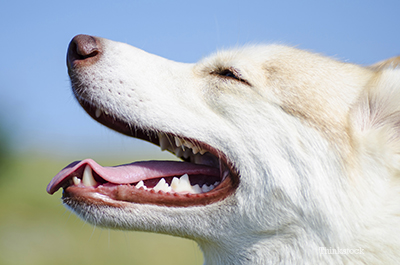
The “carnasial” tooth or more correctly the upper fourth premolar is one of the primary chewing teeth of carnivores. It functions as a shearing tooth to shred food and is the largest tooth in your dog’s mouth. It is a somewhat flattened tooth in the upper jaw (maxilla) just below the eye. Because this is a major tooth that is important in chewing (its role being slicing and grinding food being chewed) it is somewhat prone to injury and secondary problems. This tooth frequently accumulates excessive tarter, perhaps, in part because of its proximity to the duct of the parotid salivary gland1.
The upper fourth premolar often demonstrates extensive gingivitis and gum retraction. To prevent this buildup it is necessary to practice good oral hygiene and to maintain good oral health through regular brushing of the teeth and regular preventive dental care by a veterinarian1. Click here to see a video about how to brush your dog's teeth.
The carnasial tooth is particularly prone to “slab fractures” and cracking that often allow exposure of the root canal and result in secondary infections. Slab fractures of this tooth should be treated aggressively. Oral radiographs should be a regular part of the dental examination to evaluate the roots of all teeth. Cracked or broken teeth should be evaluated for exposure of the pulp cavity. If the pulp cavity is open there is an increased risk of infection.
Anatomy of the carnasial tooth
The carnasial tooth has three distinct roots and each of them may be involved in an infection. Recent fractures may be sealed and capped but more long standing exposures may require a root canal. If infection is allowed to continue the root system will become infected and may ultimately cause an abscess formation. Carnasial tooth abscesses may open and drain between the tooth and the gum tissue but it is common for the abscess to involve the maxillary facial bone that overlies the tooth. The result will be an abscess that extends to the facial tissue just below the eye.
Clinical signs of tooth abscess in dogs
Abscessed teeth will commonly drain around the gum line but in the case of the carnasial tooth the roots are very close to the skin just below the eye. Gaurdians may often see a draining track just below the eye that discharges blood tinged fluid and pus. A complete oral examination may reveal chips or cracks of teeth.
Causes of tooth abscess in dogs
The primary cause of carnasial abscesses is bacteria getting into the roots of the tooth either by way of the area between the gums and the tooth or more commonly from bacteria that enter the pulp cavity by way of a fracture or crack in the tooth2.
Diagnosis of tooth abscess in dogs
The most obvious sign of carnasial tooth abscess is a swelling on the side of the face just below the eye. Frequently this lump will drain blood or purulent material.
Less obviously the clinical signs will be visible as a draining tract in the mouth stemming from the area of the tooth root.
Confirmatory diagnosis and evaluation of the extent of an abscess requires dental radiographs that allow visualization of the entire root.
Treatment of tooth abscess in dogs
Depending on the duration and extent of the abscess there are two general treatment approaches. The first being a root canal and the second being extraction of the affected tooth. Antibiotics are given to prevent or resolve infections and pain relievers may well be needed. Root canal procedures require very specialized training and equipment and success is not assured. Extraction is curative but not simple. This tooth has three large roots and the tooth must be removed in two parts.
Although this is a major tooth the negative impact of extraction are minimal and your dog can function normally without the tooth.
Any fractured teeth should be evaluated by radiographs to determine the best treatment option
Prognosis of tooth abscess in dogs
With prompt and appropriate treatment by a veterinarian skilled in veterinary dentistry, the prognosis for salvaging the tooth is good. In more long standing abscesses the prognosis is less positive. The prognosis with extraction is also very good, as mentioned above.
Prevention of tooth abscess in dogs
Fractures of the carnasial tooth and subsequent abscesses can be prevented by not allowing dogs to chew on rocks or bones, both of which are common causes of dental injuries.
Prompt attention to fractured teeth will help prevent abscess formation. Should your dog break or crack a tooth see your veterinarian at once to prevent the tooth from becoming infected.
Questions to ask your veterinarian
- Is it OK for my dog to chew on bones?
- What is the recurrent swelling on the side of my dog’s face just below his eye?
- My dog has an abscessed tooth that is draining below his eye. What is the best treatment?
If you have any questions or concerns, you should always visit or call your veterinarian -- they are your best resource to ensure the health and well-being of your pets.
